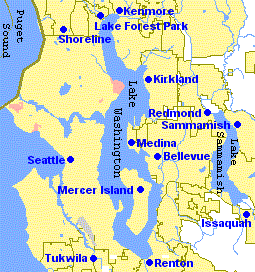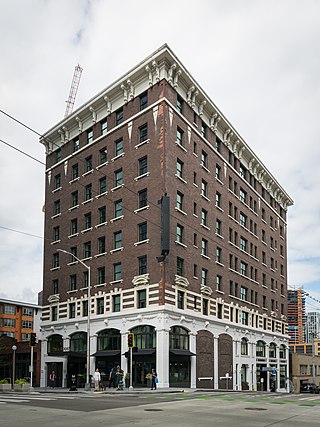
Renton is a city in King County, Washington, United States, and an inner-ring suburb of Seattle. Situated 11 miles (18 km) southeast of downtown Seattle, Renton straddles the southeast shore of Lake Washington, at the mouth of the Cedar River. As of the 2020 census, the population of Renton was 106,785, up from 90,927 at the 2010 census. The city is currently the 6th most populous municipality in greater Seattle and the 8th most populous city in Washington.

Lake Washington is a large freshwater lake adjacent to the city of Seattle, Washington, United States. It is the largest lake in King County and the second largest natural lake in the state of Washington, after Lake Chelan. It borders the cities of Seattle on the west, Bellevue and Kirkland on the east, Renton on the south, and Kenmore on the north, and encloses Mercer Island. The lake is fed by the Sammamish River at its north end and the Cedar River at its south.

This is the main article of a series that covers the history of Seattle, Washington, a city in the Pacific Northwest region of the United States of America.

The Seattle and Walla Walla Railroad was a 3 ft narrow gauge railroad and was the first proper railroad to serve Seattle, Washington, preceded only by horse-drawn rail vehicles and by a coal train making the very short haul from Lake Union to Pike Street. Despite its ambitious name, actual construction never went beyond King County, the county of which Seattle itself is the seat. After being sold to Henry Villard's Oregon Improvement Company in 1880 it was renamed the Columbia and Puget Sound Railroad. In 1916, that became the Pacific Coast Railroad Company.

The Eastside of the King County, Washington area in the United States is a collective term for the suburbs of Seattle located on the east side of Lake Washington.
The term seven hills of Seattle refers unofficially to the hills the U.S. city was built on and around, though there is no consensus on exactly which hills it refers to. The term has been used to refer to several other cities, most notably Rome and Constantinople.

Architectural terracotta refers to a fired mixture of clay and water that can be used in a non-structural, semi-structural, or structural capacity on the exterior or interior of a building. Terracotta pottery, as earthenware is called when not used for vessels, is an ancient building material that translates from Latin as "baked earth". Some architectural terracotta is actually stronger than stoneware. It can be unglazed, painted, slip glazed, or glazed.
The Woodinville Subdivision is a railroad line that was formerly owned by BNSF Railway. It takes its name from one of its original end points in Woodinville, Washington, United States. The line extends approximately 42 miles (68 km) in east King County and Snohomish County. The line's ownership has been transferred in a deal involving King County and the Port of Seattle. The section from Snohomish to Woodinville was operated, on contract, by a company called Eastside Rail Freight, which is associated with the Ballard Terminal Railroad and Meeker Southern. However, train traffic on the subdivision is exceedingly rare, with the Seattle region's rail operations now conducted on other higher capacity routes.

Reginald Heber Thomson was a self-taught American civil engineer. He worked in Washington state, mainly in Seattle, where he became city engineer in 1892 and held the position for two decades. Alan J. Stein wrote that Thomson "probably did more than any other individual to change the face of Seattle" and was responsible for "virtually all of Seattle's infrastructure".

David Thomas Denny was a member of the Denny Party, who are generally collectively credited as the founders of Seattle, Washington, United States. Though he ultimately underwent bankruptcy, he was a significant contributor to the shape of the city. Roger Sale, in his book Seattle, Past to Present, described him as having been "the pioneer to turn to if one had a plan that would be 'good for Seattle', and one needed a respectable tone and a willing investor."
Terra Cotta is a former mining town in Riverside County. It was established in 1887, in the Warm Springs Valley northwest of the town of Lake Elsinore, and later incorporated into the City of Lake Elsinore.

The Arctic Club Building is a ten-story hotel in Seattle, Washington located at the Northeast corner of Third Avenue and Cherry Street. Built in 1914 for the Arctic Club, a social group established by wealthy individuals who experienced Alaska's gold rush, it was occupied by them from construction until the club's dissolution in 1971. It is entirely faced with cream white terra cotta with submarine blue and orange-brown accents. The building is recognizable by the terra cotta walrus head sculptures lining the third floor of the building and its iconic polar bear in the Polar Bar, the hotel's bar and cocktail lounge. It is one of the finest examples of multi-colored matte glaze terra cotta work in the city. Recently restored, the building has been adapted for use as a luxury hotel, Arctic Club Seattle. A rooftop garden used by the social club was replaced with a penthouse office suite.

The Federal Office Building, Seattle, Washington is a historic federal office building located at Seattle in King County, Washington.

Gladding, McBean is a ceramics company located in Lincoln, California. It is one of the oldest companies in California, a pioneer in ceramics technology, and a company which has "contributed immeasurably" to the state's industrialization. During the heyday of architectural terra cotta, the company "dominated the industry in California and the Far West."

California pottery includes industrial, commercial, and decorative pottery produced in the Northern California and Southern California regions of the U.S. state of California. Production includes brick, sewer pipe, architectural terra cotta, tile, garden ware, tableware, kitchenware, art ware, figurines, giftware, and ceramics for industrial use. Ceramics include terra cotta, earthenware, porcelain, and stoneware products.
Alberhill is an unincorporated community in Riverside County, California. Alberhill is located 5.5 miles (8.9 km) northwest of Lake Elsinore. It lies at an elevation of 1234 feet. Alberhill was named after C.H. Albers and James and George Hill.
Carnegie was a town in Corral Hollow, in San Joaquin County, California from 1902 to about 1915.

Taylor is a ghost town in King County, in the U.S. state of Washington.

The Calhoun Hotel, later known as the Palladian Apartments and currently the Kimpton Palladian Hotel is a historic hotel building located in downtown Seattle, Washington. Constructed in 1909, The building was built on the recently regraded northeast corner of Second Avenue and Virginia Streets by Scott Calhoun (1874-1952), a well known attorney and Seattle's Corporation Counsel who helped form the Port of Seattle. He commissioned prominent local Architect W. P. White to design an eight-story hotel building, containing 153 rooms on the upper floors and retail at ground level. It was the first building to be completed on the site of the Denny Regrade. It was listed on the National Register of Historic Places on April 23, 2013. Converted to apartments by the 1980s, In 2014 it was restored back into a hotel and is currently run by the Kimpton Hotels & Restaurants brand as the Kimpton Palladian Hotel.

The Central Building is a historic building at 810 3rd Avenue in downtown Seattle, in the U.S. state of Washington.
















